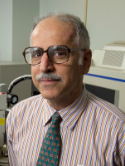Cryo-EM structure of DNA-bound Smc5/6 reveals DNA clamping enabled by multi-subunit conformational changes Journal Article
| Authors: | Yu, Y.; Li, S.; Ser, Z.; Kuang, H.; Than, T.; Guan, D.; Zhao, X.; Patel, D. J. |
| Article Title: | Cryo-EM structure of DNA-bound Smc5/6 reveals DNA clamping enabled by multi-subunit conformational changes |
| Abstract: | Structural maintenance of chromosomes (SMC) complexes are essential for chromatin organization and functions throughout the cell cycle. The cohesin and condensin SMCs fold and tether DNA, while Smc5/6 directly promotes DNA replication and repair. The functions of SMCs rely on their abilities to engage DNA, but how Smc5/6 binds and translocates on DNA remains largely unknown. Here, we present a 3.8 Å cryogenic electron microscopy (cryo-EM) structure of DNA-bound Saccharomyces cerevisiae Smc5/6 complex containing five of its core subunits, including Smc5, Smc6, and the Nse1-3-4 subcomplex. Intricate interactions among these subunits support the formation of a clamp that encircles the DNA double helix. The positively charged inner surface of the clamp contacts DNA in a nonsequence-specific manner involving numerous DNA binding residues from four subunits. The DNA duplex is held up by Smc5 and 6 head regions and positioned between their coiled-coil arm regions, reflecting an engaged-head and open-arm configuration. The Nse3 subunit secures the DNA from above, while the hook-shaped Nse4 kleisin forms a scaffold connecting DNA and all other subunits. The Smc5/6 DNA clamp shares similarities with DNA-clamps formed by other SMCs but also exhibits differences that reflect its unique functions. Mapping cross-linking mass spectrometry data derived from DNA-free Smc5/6 to the DNA-bound Smc5/6 structure identifies multi-subunit conformational changes that enable DNA capture. Finally, mutational data from cells reveal distinct DNA binding contributions from each subunit to Smc5/6 chromatin association and cell fitness. In summary, our integrative study illuminates how a unique SMC complex engages DNA in supporting genome regulation. Copyright © 2022 the Author(s). |
| Keywords: | controlled study; unclassified drug; nonhuman; binding affinity; dna replication; protein conformation; cohesin; cell cycle protein; metabolism; cell cycle proteins; carboxy terminal sequence; protein dna binding; protein stability; dna; double stranded dna; amino terminal sequence; saccharomyces cerevisiae; chromatin; heterozygosity; binding site; dna sequence; dimerization; conformational transition; structural maintenance of chromosome 5; structural maintenance of chromosome 6; protein structure; condensin; chromosome protein; static electricity; protein cross linking; ligation; image reconstruction; cryoelectron microscopy; kleisin; alpha helix; peptides and proteins; cryo-em; constriction; three-dimensional imaging; smc5/6; article; dna clamp; kite proteins; nse1 protein; nse3 protein; nse4 protein |
| Journal Title: | Proceedings of the National Academy of Sciences of the United States of America |
| Volume: | 119 |
| Issue: | 23 |
| ISSN: | 0027-8424 |
| Publisher: | National Academy of Sciences |
| Date Published: | 2022-06-07 |
| Start Page: | e2202799119 |
| Language: | English |
| DOI: | 10.1073/pnas.2202799119 |
| PUBMED: | 35648833 |
| PROVIDER: | scopus |
| PMCID: | PMC9191643 |
| DOI/URL: | |
| Notes: | Article -- Export Date: 1 August 2022 -- Source: Scopus |
Altmetric
Citation Impact
BMJ Impact Analytics
Related MSK Work









